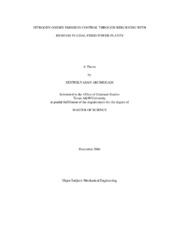| dc.description.abstract | Oxides of nitrogen from coal-fired power stations are considered to be major pollutants, and there is increasing concern for regulating air quality and offsetting the emissions generated from the use of energy. Reburning is an in-furnace, combustion control technology for NOx reduction. Another environmental issue that needs to be addressed is the rapidly growing feedlot industry in the United States. The production of biomass from one or more animal species is in excess of what can safely be applied to farmland in accordance with nutrient management plans and stockpiled waste poses economic and environmental liabilities. In the present study, the feasibility of using biomass as a reburn fuel in existing coal-fired power plants is considered. It is expected to utilize biomass as a low-cost, substitute fuel and an agent to control emission. The successful development of this technology will create environment-friendly, low cost fuel source for the power industry, provide means for an alternate method of disposal of biomass, and generate a possible revenue source for feedlot operators. In the present study, the effect of coal, cattle manure or feedlot biomass, and blends of biomass with coal on the ability to reduce NOx were investigated in the Texas A&M University 29.31 kW (100,000 Btu/h) reburning facility. The facility used a mixture of propane and ammonia to generate the 600 ppm NOx in the primary zone. The reburn fuel was injected using air. The stoichiometry tested were 1.00 to 1.20 in the reburn zone. Two types of injectors, circular jet and fan spray injectors, which produce different types of mixing within the reburn zone, were studied to find their effect on NOx emissions reduction. The flat spray injector performed better in all cases. With the injection of biomass as reburn fuel with circular jet injector the maximum NOx reduction was 29.9 % and with flat spray injector was 62.2 %. The mixing time was estimated in model set up as 936 and 407 ms. The maximum NOx reduction observed with coal was 14.4 % and with biomass it was 62.2 % and the reduction with blends lay between that of coal and biomass. | en |


